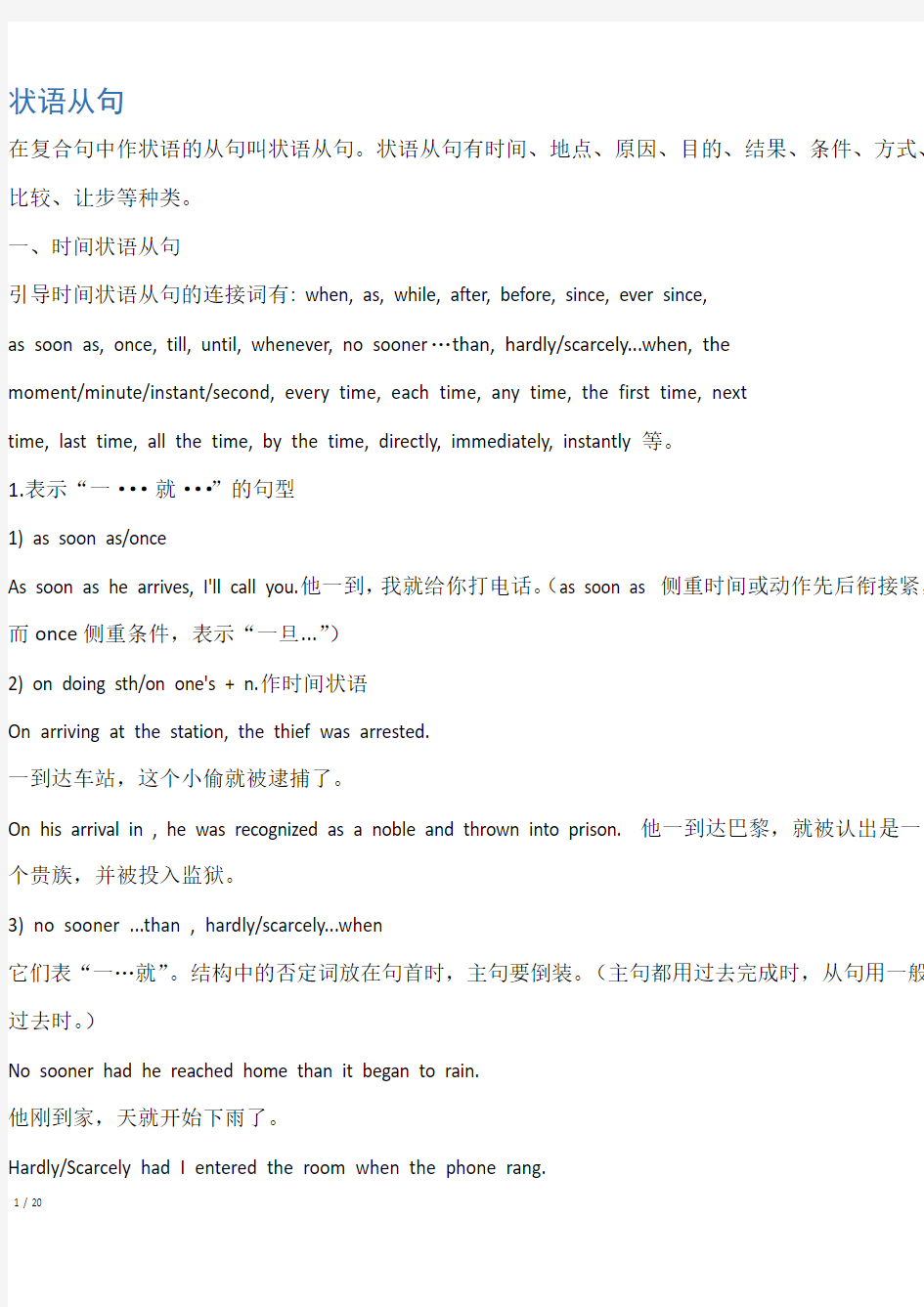状语从句9种全


状语从句在复合句中作状语的从句叫状语从句。状语从句有时间、地点、原因、目的、结果、条件、方式、比较、让步等种类。
一、时间状语从句引导时间状语从句的连接词有: when, as, while, after, before, since, ever since, as soon as, once, till, until, whenever, no sooner…than, hardly/scarcely...when, the moment/minute/instant/second, every time, each time, any time, the first time, next time, last time, all the time, by the time, directly, immediately, instantly等。
1.表示“一···就···”的句型1) as soon as/once As soon as he arrives, I'll call you.他一到,我就给你打电话。(as soon as 侧重时间或动作先后衔接紧,而once侧重条件,表示“一旦...”)2) on doing sth/on one's + n.作时间状语On arriving at the station, the thief was arrested. 一到达车站,这个小偷就被逮捕了。On his arrival in , he was recognized as a noble and thrown into prison. 他一到达巴黎,就被认出是一个贵族,并被投入监狱。
3) no sooner ...than , hardly/scarcely...when 它们表“一…就”。结构中的否定词放在句首时,主句要倒装。(主句都用过去完成时,从句用一般过去时。)No sooner had he reached home than it began to rain. 他刚到家,天就开始下雨了。Hardly/Scarcely had I entered the room when the phone rang.
1 / 20
我一进屋,电话就响了。
注意当no sooner, hardly, scarcely不放在句首时,主句不倒装,如:
I had no sooner reached the bus stop than the bus started.
我刚到车站,车就开走了。
I had scarcely(hardly)entered the room when the phone rang.
4)the moment, the instant, the minute, the second
The moment I saw him, I recognized him.
我一看见他,就认出了他。
We'll leave the minute you are ready.
你一准备好,我们就出发。
5)有些副词如:instantly, immediately, directly可用作连词,后接从句。
I left immediately the clock struck 5.
我刚走,钟就敲了五点。
2. when, while, as引导时间状语从句
1) when的用法
①when既可指时间点,也可指时间段(即:从句动词可以是短暂的也可是延续的);主从句动作可同时也可先后发生。
I was thin when I was a child.
当我是个孩子的时候,我很瘦。
It was raining when I arrived.我到达时,天正在下雨。
②在when引导时间状语从句时,如果从句主语与主句主语相同或为it,且从句有be动词,则从句可省主语和be动词,如:
2 / 20
When (you are) in trouble, you can visit this man.
当你有麻烦时,可以找这个人。
She is always listening to music when(she is) doing her homework. 当她做作业时,总是听音乐。
③when在下列结构中, 译成“这时”,它引导的是并列句be about to do ... when, be doing ... when, had done ···when, be on one's way ... when, be on the point of doing ... when(参见“连词”部分when的用法)2)while用法
while只能指一段时间,从句中的动词必须是延续性动词。强调某一段时间内发生主句动作,相当于during the time that....
My mother was cooking while I was doing my homework. 当我在做作业时,妈妈在做饭。
I am safe while I am here.我在这儿的时候,我很安全。注意while除引导时间状语从句外,还引导对比句,作“然而”讲;并可在句首引出让步状语从句作“虽然···但”讲。
I like watching TV, while he likes reading. 我喜欢看电视,而他喜欢读书。While he has his own car, he often uses mine. 尽管他自己有车,他却常用我的。
3) as的用法
①as引导时间状语从句时常可和when换用,但较强调同时发生,多指短暂动作。
3 / 20
As I left the house, I forgot the key.我离家时,忘了带钥匙。
②as还可说明两种正在发展或变化的情况,“随着...”的意思,表时间的推移。如:As I get older, I get more optimistic. 随着年龄的增长,我变得更加乐观。
③as表“一边…一边…”,引出伴随动作。He hurried home, looking behind as he went. 他匆忙地回家,边走边往后看。④用以强调两个动作紧接着发生。
As he was going out, it began to rain.
当他出去的时候,天开始下雨了。
⑤as有时引出一个名词,相当于一个时间状语从句。As a boy (when he was a boy), he was hopeless at maths. 当他是孩子时,他对数学失去希望。
3. before引导的时间状语从句
①before引导的时间状语从句不用否定式谓语。Before they got to the bus stop, the bus had gone. 在他们到达公共汽车站之前,公共汽车已经走了。
②在“It be + 时间段+ before从句”句型中,肯定句译成“…(之后)才”,否定句译成“…就”。该句型有一般过去时、过去将来时、一般将来时三个时态,且有否定句。It will be some time before... do...
4 / 20
It was some time before...did...
It would be some time before...did...
It was long before...did...“很久才···”It wasn't long before...did...“不久就...”It will be many years before the chemicals start to escape from the containers. 多年以后化学物质才开始从容器中逃逸。It was not long before he came back.不久他就回来了。It was a long time before he got to sleep again. 很久他才再次入睡。
It was a week before he could tell his story. 一个星期后他才能讲述他的经历。
It wasn't long before he told us about himself. 不久他就给我们讲述了他自己的故事。
▲before可译成“未来得及”
He had measured me before I could get a word.
我还未来得及插话,他就量好了尺寸。
▲before可译成“趁着还没”
I'll write it down before I forget.
趁着还没忘我要把它写下来。
4. until和till
5 / 20
1)“延续性动词肯定式+until”表示“动作延续到…为止,”译为“直到…为止”,如:
I waited for him until he came back. 我一直等到他回来。
2)“终止性动词的否定式+ until”表示“直到···才”。
He didn't go to bed until he had finished his work. 直到完成工作他才睡觉。
3)用于强调句式“It is not until ...that ...”
It was not until the professor came that we began the experiment.
在教授到来之后,我们才开始实验。
4) not until放在句首时,主句倒装。
注意句首和强调句中要用until,而不用till;not...until...句型中不用till。
5. since引导时间状语从句,意为“自从…时起”,主句要用完成时。
Mr. Li has been here since he came back.
自先生回来以后,他一直在这儿。
I haven't heard from him since he lived here.
自从他住在这儿以来,我就没有收到过他的来信。
I've known Mr. Smith since I was a boy.
我小的时候就认识先生了。
6.时间状语从句的省略式
当时间状语从句的主语和主句主语相同或为it,从句又含be动词时,从句可省略主语和be动词。
在不产生歧义时,连词也可省去。如:Once (it is) seen, it can never be forgotten. 一旦被看见过,永远也不会被忘记。
6 / 20
二、地点状语从句
1.地点状语从句主要由where, wherever anywhere, everywhere引导。We must camp where we can get water. 我们必须在能找到水的地方露营。
I will follow you wherever you go. 无论你到何处我都要跟随你。
2.地点状语从句与定语从句的区别:where引导定语从句,从句前应有一个表示地点的名词作先行词。Go back where you came from.(where引导地点状语从句)Go back to the village where you came from. (where引导定语从句,village为先行词)三、原因状语从句原因状语从句由because, as , since, now (that)(既然), in that(因为,多于口语中),seeing (that)(鉴于,由于),considering that(考虑到)等引导。
1. because用来回答why提出的问题,表直接的因果关系,用于告知对方不知道的原因,语气最强,可用于强调句。He didn't attend the meeting because he was ill. 他没参加会议,因为他病了。It was because he was ill that he didn't go with us. 因为他有病,他没有和我们一起去。注意because和because of的区别:because是连词,引导从句,because of是短语介词,后接名词性词语,如:
7 / 20
The football match was put off because it rained. The football match was put off because of the rain. 因为下雨,足球赛延期了。
2. since, as, now that引导的原因状语从句,不能用于强调句。
①since的语气比because稍弱,表示关系上的自然结果,特别用于原因已经清楚了的事情,一般译成“既然,鉴于”(往往放在主句之前)如:Since you have known the secret, I needn't say anything about it. 既然你已经知道了这个秘密,我就不必说了。
②as语气最弱,说明一般的因果关系,表显而易见的原因或倒果为因的说法(可放在主句之前,亦可放在主句之后),如:
As he didn't know much English, he got out his dictionary and looked up the word “cough”.
他对英语懂得不多,他拿出字典查找“cough”这个词。As the ground is wet, it must have rained last night.(倒果为因)昨晚一定下了雨,地面是湿的。
③now that用来说明一种新情况,然后加以推论。now that放句首时that可省略:Now (that) everybody is here, let's begin.
3. for也可以表示原因,属并列连词,不是说明直接原因,而是对某种情况加以推断,表示补充说明理由。而推断的理由会因人而异。语气很弱,它引出的分句必须放在另一分句后。He must be ill, for he is absent today.
4.原因状语从句有时可以用分词形式表现。
8 / 20
As he was blind, he couldn't see anything. Being blind, he couldn't see anything.
